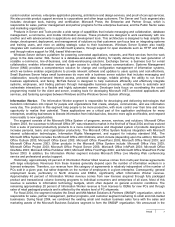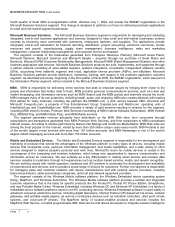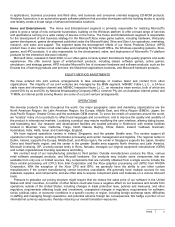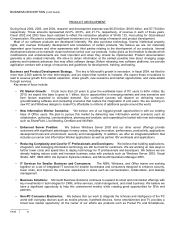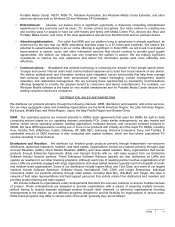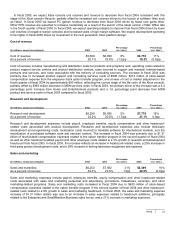Microsoft 2004 Annual Report Download - page 17
Download and view the complete annual report
Please find page 17 of the 2004 Microsoft annual report below. You can navigate through the pages in the report by either clicking on the pages listed below, or by using the keyword search tool below to find specific information within the annual report.
PAGE 17
We continue to watch the evolution of open source software development and distribution, and continue to differentiate
our products from competitive products including those based on open source software. We believe that Microsoft’s share
of server units grew modestly in fiscal 2004, while Linux distributions rose slightly faster on an absolute basis. The
increase in Linux distributions reflects some significant public announcements of support and adoption of open source
software in both the server and desktop markets in the last year. To the extent open source software products gain
increasing market acceptance, sales of our products may decline, which could result in a reduction in our revenue and
operating margins.
Additionally, due primarily to our announced special dividend and quarterly dividend payments, if continued, we expect
investment balances and resulting investment income to decrease significantly in fiscal 2005.
We have approximately $1.1 billion in original Upgrade Advantage contract value that will reach their expiration dates in
the first quarter of fiscal 2005. This revenue was recognized over the last two years and in the first quarter of fiscal 2005
the contract period expires.
Summary
(In millions, except percentages) 2002 2003
Percentage
inc./ (dec.) 2004
Percentage
inc./ (dec.)
Revenue $28,365 $32,187 13% $36,835 14%
Operating income $ 8,272 $ 9,545 15% $ 9,034 (5)%
Our revenue growth for fiscal 2004 was driven by licensing of Windows Client operating systems through OEMs; Windows
Server operating systems, Office, and other server applications as a result of growth in PC and server hardware
shipments; and the continuing impact from multi-year licensing that occurred prior to the transition to our Licensing 6.0
program in the first quarter of fiscal 2003. We estimate growth in PC shipments was 13% during fiscal 2004, reflecting
global economic improvement, which led to strength in the consumer segment in the first half of fiscal 2004 and to
replacement PC and notebook sales in the enterprise segment in the second half of fiscal 2004. We estimate that total
server hardware shipments grew 16%, with Windows Server shipments growing faster than the overall sector at 18% in
fiscal 2004. The net impact of foreign exchange rates on revenue was positive in fiscal 2004, primarily due to a relative
strengthening of most foreign currencies versus the U.S. dollar. Had the rates from the prior year been in effect in fiscal
2004, translated international revenue earned in local currencies would have been approximately $1.10 billion lower. We
hedge a portion of our international currency exposures, thereby reducing our overall translation exposure. Prior to the
July 31, 2002 Licensing 6.0 transition date, we experienced a significant increase in multi-year licensing arrangements as
customers enrolled in our maintenance programs, primarily Upgrade Advantage. Revenue growth in fiscal 2003 was
driven primarily by multi-year licensing that occurred before the Licensing 6.0 transition date in the first quarter of fiscal
2003. The revenue growth also reflected a $933 million or 13% increase associated with OEM licensing of Microsoft
Windows operating systems and a $309 million or 23% increase in revenue from Microsoft Xbox video game consoles.
Revenue growth in fiscal 2002 was led by the addition of $1.35 billion of Xbox video game system revenue and $1.20
billion of revenue growth from Microsoft Windows XP Professional and Home operating systems.
For fiscal 2004, the operating income decline of $511 million was primarily caused by the $2.53 billion of charges
related to the Sun Microsystems settlement and a fine imposed by the European Commission in the third quarter of fiscal
2004 and $2.21 billion of stock-based compensation expense related to our employee stock option transfer program in the
second quarter of fiscal 2004. Operating income was positively influenced by the revenue growth described above and
operational improvements in our MSN business. In fiscal 2003, the growth in operating income reflected an increase of
$3.82 billion in revenue, partially offset by an increase of $2.55 billion in operating expenses, primarily related to employee
and related costs associated with additional headcount and increased legal settlement expenses, primarily the Time
Warner settlement charge of $750 million. In fiscal 2002, the growth in operating income reflected an increase of $3.07
billion in revenue, substantially offset by an increase of $3.14 billion in operating expenses, which included the onset of
costs related to Xbox video game systems.
We adopted the fair value recognition provisions of SFAS 123, Accounting for Stock-Based Compensation, on July 1,
2003 and restated prior periods to reflect compensation cost under the recognition provisions of SFAS 123 for all awards
granted to employees after July 1, 1995. Stock-based compensation expenses are included in operating expenses as part
of headcount-related costs. Total stock-based compensation costs included in operating expenses were $5.73 billion in
fiscal 2004, $3.75 billion in fiscal 2003, and $3.78 billion in fiscal 2002.
In fiscal 2005, we do not expect revenue to grow at similarly high rates as fiscal 2004, even if information technology
spending continues to improve. While we expect general economic conditions to remain stable with the improvements
seen in the second half of fiscal 2004, we expect PC and server unit shipment growth rates to decline in fiscal 2005 from
the high growth rates in fiscal 2004. We estimate PC shipments will grow from 7% to 9% and Server unit shipments will


